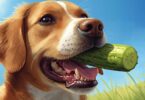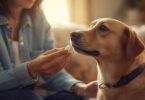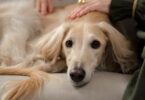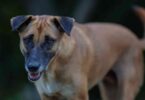Imagine a dog that combines the spunky confidence of a small breed with the big-hearted loyalty of a family favorite. That’s the magic of the Dachshund cross Lab—a playful hybrid capturing hearts nationwide. These pups blend distinct traits from their parent breeds, creating a one-of-a-kind companion perfect for active households.
Designer dogs like this mix often showcase hybrid vigor, inheriting strengths from both lineages. You’ll notice compact builds paired with expressive eyes and wagging tails. Their personalities balance curiosity and calmness, making them adaptable to apartments or homes with yards.
Potential owners should prepare for moderate energy levels and a love for exploration. Training requires patience, as stubbornness from one parent might clash with the other’s eagerness to please. Socialization and consistent routines help these dogs thrive.
This guide dives into everything you need to know. We’ll explore their origins, ideal diets, grooming needs, and exercise tips. Whether you’re researching adoption or simply curious about this unique crossbreed, you’ll find actionable insights to make informed decisions.
Breed Origins and Unique Characteristics
This designer breed’s story begins with two parent breeds known for contrasting traits. The Dachshund Labrador mix combines a determined hunting hound with America’s most popular family companion. Breeders aimed to merge the Dachshund’s bold personality with the Labrador Retriever’s adaptable nature.
Parent Influence: Dachshund and Labrador Heritage
The Dachshund contributes a compact frame and strong prey drive, while the Labrador Retriever adds athleticism and social charm. You might see puppies that look like miniature versions of Labradors or inherit the Dachshund’s elongated torso. Their coats range from short and dense to slightly wavy, depending on genetic dominance.
Temperament varies widely in these mixes. Some display the Dachshund’s independent streak, while others mirror the Labrador’s people-pleasing attitude. Early socialization helps balance these traits, creating dogs that adapt well to different living situations.
Designer Breed Trends and Recognition
While not officially recognized by major kennel clubs, the Dachshund Labrador mix thrives in designer dog communities. Breeders often highlight hybrid vigor—the potential for fewer health issues than purebred parents. These dogs appeal to owners seeking unique appearances, as no two litters look exactly alike.
Current trends show growing interest in medium-sized hybrids that blend working-dog intelligence with companion traits. Prospective owners should research reputable breeders who prioritize health testing over following fleeting fads.
Traits and Personality Insights
The Dachshund-Labrador blend brings together two iconic breeds in one dynamic package. This hybrid often showcases a playful mix of physical and behavioral traits that surprise first-time owners. Let’s break down what makes these dogs stand out.
Distinct Physical Features
These medium-sized dogs typically weigh 25-45 pounds, with sturdy builds reflecting both parent breeds. Their bodies might show a slightly elongated torso or a more athletic Labrador-like frame. Coat textures vary—some inherit short, smooth fur, while others develop denser double coats.
Ears often flop forward like a Labrador’s, though some puppies display the Dachshund’s signature tapered shape. Eye color ranges from deep brown to hazel, paired with expressive eyebrows that amplify their charm. Paw size usually lands between the two parent breeds, making them agile for outdoor adventures.
Temperament and Behavioral Attributes
Expect a lively yet affectionate companion. This combination balances a love for playtime with moments of calm snuggling. They thrive on human interaction, often shadowing family members around the house. Early socialization helps curb any stubborn tendencies inherited from their hunting lineage.
Puppies usually show bold curiosity within weeks, exploring their surroundings with gusto. As adults, they adapt well to routines—whether it’s morning walks or evening fetch sessions. Their loyalty makes them excellent watchdogs, though they rarely show aggression toward strangers.
Families appreciate their patience with children and compatibility with other pets. Regular mental stimulation prevents boredom-related behaviors, ensuring a harmonious household.
Grooming and Coat Care for Your Hybrid
Maintaining your dog’s coat starts with identifying their fur type. These hybrids inherit traits from both parent breeds, resulting in three common variations: smooth short hair, dense double coats, or longer wavy fur. Each type demands specific care to keep skin healthy and shedding manageable.
Coat Types, Shedding, and Maintenance
Smooth-coated animals need weekly brushing with a rubber curry mitt. Double-coated breeds shed heavily in spring and fall—daily brushing with an undercoat rake prevents mats. For wavy fur, use a slicker brush every 3-4 days to avoid tangles.
All types benefit from monthly baths with oatmeal shampoo. Trim nails every 3 weeks to protect their body from posture issues. Check ears weekly for debris, especially if your pet loves outdoor adventures.
Some dogs resist grooming due to their temperament. Start sessions early using positive reinforcement. Keep a chew toy nearby to distract anxious pets. For heavy shedders, try a de-shedding tool like the Furminator during peak seasons.
Dental care matters too. Brush teeth 2-3 times weekly with enzymatic toothpaste. Pair grooming with playtime to create positive associations. With consistent routines, even stubborn animals learn to tolerate—and enjoy—these bonding moments.
Health Considerations and Preventive Care
Smart pet ownership involves understanding potential health risks and prevention strategies for your hybrid companion. While designer dogs often benefit from genetic diversity, their mixed heritage can introduce specific vulnerabilities. Proactive care helps maximize wellness and address issues before they escalate.
Identifying Common Health Concerns
These hybrids may inherit conditions from both parent breeds. Orthopedic issues like intervertebral disc disease (IVDD) are common due to spinal structure characteristics. Eye conditions such as progressive retinal atrophy also appear in some lines. Regular vet screenings help catch these early.
The designer nature of these dogs doesn’t guarantee immunity to genetic problems. Reputable breeders test parent dogs for hereditary conditions, but mixed lineages can still carry risks. Watch for signs of joint stiffness or vision changes during routine play.
Strategies for Longevity and Wellness
Schedule bi-annual vet check-ups to monitor weight and joint health. Keep kids involved by teaching them to recognize discomfort signals during play. Use puzzle feeders to slow eating and prevent bloat—a common issue in active breeds.
Maintain lean body mass through controlled portions and low-impact exercises like swimming. Families can improve their dog’s quality of life by creating consistent routines and avoiding high-impact activities that stress the spine. Early intervention often makes all the difference in managing chronic conditions.
Nutritional Needs and Feeding Guidelines
Proper nutrition forms the foundation of a healthy life for your hybrid companion. These energetic dogs require balanced meals that support their unique metabolism and activity levels. Tailoring their diet helps prevent weight-related issues while fueling their playful nature.
Choosing the Best Dry Dog Food
High-quality dry dog food with 20-30% protein supports muscle health in active mixes. Look for options containing omega fatty acids to maintain coat shine and joint supplements like glucosamine. Brands like Purina Pro Plan Sensitive Skin & Stomach or Blue Buffalo Life Protection meet these needs without excessive fillers.
Portion control matters for these food-motivated pets. Split daily meals into two servings using a measuring cup. Puppies under 12 months benefit from three smaller meals to stabilize energy levels.
Diet Tips for Weight Control
Monitor treats to avoid overfeeding—low-calorie snacks like green beans work well. Excess weight strains the back, increasing injury risks. Swap 10% of kibble with steamed veggies for added fiber and fullness.
Consult your vet about calorie needs based on age and exercise habits. Pair consistent feeding schedules with interactive toys to slow eating. For personalized advice, explore expert health care tips addressing hybrid-specific needs.
Exercise and Mental Stimulation Essentials
Keeping your hybrid pup happy requires a smart mix of activities that cater to their unique blend of traits. These energetic companions thrive when their physical stamina and curious minds get equal attention. Let’s explore how to create balanced routines that keep tails wagging.
Daily Physical Activity Recommendations
Aim for 45-60 minutes of daily exercise split into multiple sessions. Morning walks paired with evening playtime work well for this mix. Short, frequent activities prevent joint strain while satisfying their Labrador Retriever Dachshund heritage.
Try scent trails in your backyard or local park to engage their hunting instincts. Swimming offers low-impact cardio that protects sensitive spines. Always monitor dogs with progressive retinal atrophy in bright sunlight—shaded areas or twilight hours work best.
Interactive Toys and Brain Games
Challenge their intelligence with puzzle feeders like the KONG Classic or Outward Hound Hide-A-Squirrel. These toys tap into problem-solving skills inherited from both parent breeds. Rotate toys weekly to maintain novelty and prevent boredom.
Teach new commands during 10-minute training sessions using high-value treats. Games like “find the toy” stimulate mental focus while burning energy. For bulldog Dachshund mix relatives, use softer toys to protect dental health.
Balance active play with calming activities like lick mats or snuffle pads. This approach supports overall wellness, especially for dogs prone to progressive retinal atrophy. Watch for signs of fatigue, and always provide fresh water after workouts.
Training and Socialization Techniques
Building a strong bond with your hybrid companion starts with consistent training strategies. These intelligent mixes respond best to positive reinforcement and structured routines. Early lessons lay the groundwork for lifelong good behavior, especially when addressing their occasional stubborn streaks.
Housebreaking and Obedience Training Tips
Establish a predictable bathroom schedule—take puppies out after meals, naps, and play sessions. Use crate training to prevent accidents indoors, gradually increasing free-roam privileges. Reward successes immediately with treats or praise to reinforce habits.
For obedience challenges, keep sessions under 15 minutes to maintain focus. Teach basic commands like “sit” and “stay” using high-value rewards. If your dog resists, try hand signals paired with verbal cues. Consistency matters more than duration—daily practice beats weekly marathons.
Improving Social Behavior With Other Pets
Introduce new animals slowly in neutral spaces. Start with leashed meetings, watching for stiff body language or raised hackles. Use distraction techniques like fetch to redirect overexcitement during interactions.
Pair socialization with proper nutrition—regular feeding times with quality dog food stabilize energy levels. Avoid overfeeding treats during training to prevent weight issues that could worsen intervertebral disc disease risks. Always supervise playdates until trust develops naturally.
Caring for Your dachshund cross lab at Home
Designing a comfortable living space for your hybrid companion ensures their safety and happiness. Tailoring your home to their needs prevents accidents and supports their natural behaviors. Start by identifying potential hazards like loose wires or toxic plants, then create dedicated zones for play and relaxation.
Creating a Pet-Friendly Environment
Adjust furniture layouts to accommodate your dog’s size and energy. Puppies benefit from gated areas with chew-resistant bedding, while older dogs need non-slip mats near resting spots. For dogs under three years old, secure cabinets containing cleaning supplies or dry dog food to prevent mischief.
Daily routines need take into account age-related changes. Younger mixes thrive with obstacle courses made from cushions or tunnels, whereas senior pets prefer cozy nooks with orthopedic beds. Establish consistent feeding times and walking schedules to help your pet get along with household rhythms.
Indoor enrichment ideas include puzzle feeders and window perches for birdwatching. Outdoors, reinforce fencing and provide shaded digging zones. A weekly checklist helps track essentials like water bowl cleaning, toy rotation, and nail trims. These small adjustments create harmony between pets and families.
Final Thoughts on Embracing Your Hybrid Companion
Owning a hybrid dog with roots in two iconic lineages offers a rewarding journey filled with surprises. These companions blend the best of both worlds—loyalty from retriever dachshund heritage and adaptability common to modern mix breeds. Their spirited personalities and unique looks make them unforgettable additions to active households.
Proper care hinges on understanding their dual nature. Regular exercise keeps their energy balanced, while nutrient-rich diets support joint health. Stay vigilant about inherited conditions like retinal atrophy through routine vet checks. Early detection often leads to better outcomes.
For families seeking a devoted pet, this mix breed delivers charm and versatility. Their intelligence shines when paired with consistent training, and their affectionate nature fosters strong bonds. Explore resources like our complete guide to hybrid breeds for deeper insights into managing their unique traits.
By prioritizing preventive care and embracing their quirks, you’ll gain a lifelong friend. Whether hiking trails or relaxing at home, these dogs prove that thoughtful pet ownership reaps endless rewards.
FAQ
Are dachshund-Labrador mixes recognized by major kennel clubs?
No, these hybrids aren’t officially recognized by organizations like the AKC. They’re considered designer breeds, though some specialty registries may track them.
How do their temperaments compare to purebred Labs or Dachshunds?
This mix often combines a Lab’s friendliness with a Dachshund’s independence. Early socialization helps balance potential stubbornness with their natural loyalty to families.
What health screenings are recommended for this crossbreed?
Regular checks for intervertebral disc disease (common in Dachshunds) and hip dysplasia (prevalent in Labs) are crucial. Annual eye exams can also detect progressive retinal atrophy risks.










Leave a Comment